The new Plantronics CS60-USB is being billed as the world’s first VoIP wireless headset. Whether that’s accurate or not, the really interesting thing is that it has been designed to work with Skype as well as other Internet Phone services. So how does it perform? Read the rest of the Ferret review to find out…
The CS60-USB is a svelte, elegantly designed two piece system which comes with a nice selection of accessories as well as the PerSonoCall software for remote call handling. In line with most Plantronics office equipment (as opposed to consumer tech) it’s not cheap, but on the other hand the company is known for producing good quality, reliable products which offer value for money.
Click on thumbnails for larger image
First Impressions
The product is shipped in a nice weighty Plantronics box, which is a jump up from their cheaper consumer packaging. The box contains the headset itself, the DECT charger/base station, two headband mounts, spare ear clips, some velcro tags for attaching things to other things, and an AC plug adapter for those times when your USB port or hub just doesn’t have enough juice to cut the mustard. Surprise number one is the lack of even a basic ‘get started’ manual. Instead there’s a very rudimentary graphic on the back of the CD ROM papercase. It’s kind of Tonka Toys, but luckily it’s OK, since installation is quite a breeze.
Installation
Installation is a 1-2-3 affair. Assemble the DECT base station and charger combo and plug it into the USB port of the PC. If you’re using a hub make sure there’s enough power (250mA), because I got a low power warning at first, which is where the AC adapter comes in mighty handy. I suspect that mains power is probably the best way to guarantee maximum range and performance out of the DECT tech too. Once it’s all flashing lights and go, insert the CD in yer PC and go through the install procedure. The headset itself needs to be charged for 1 to 3 hours, and then you just select your choice of skull bracket, slot it onto your noggin and presto, Skype roams.
In Use
To get going you need to configure Skype to use the CS60 as the default headset, which is a straightforward Tools – Options setting. The PerSonoCall software sits in the Windows task bar after install, and you can also set up a few options in there like automatically launching applications with the headset talk button. Oh yeah, the thing also functions as a voice recognition mic if you’re a Dragon fan. To make a Skype call, fire up the Skype box, dial or select contact, and the headset will automatically pick up the call audio for you to talk. That’s it really.
The volume is nice and loud and there’s no appreciable hiss when talking from a distance. I made a Skype Out call while 15 meters away from the base in the garden and it was crystal clear, although in line with most wireless range claims, the 100 meter range is almost certainly more theoretical than fact, since the audio started to break up once I ventured a little further out. The headset does give a warning beep when you approach the range limits though, which is useful. It’s powered by a Li-Ion 190mAh rechargeable battery, and there’s a call alert sounder on the base unit which augments any Skype generated computer sound.
The big hassle is the fact that you can only accept and end calls with the single button, so if you want to make a new call from the garden you have to trudge back to the computer and use Skype on screen to do the deed. This is where alternative solutions like the Sipura SPA 2000 box and a conventional DECT wireless phone work better as a general home based VoIP system, even though it’s SIP only and can’t access the awesomely cheap Skype.
With the SIP combo you can dial calls from the garden, and you don’t need the PC plugged in either. I have a Sipura set up with a cheapo £2.00 DECT phone I picked up on eBay and it works superbly as a wireless solution. However the CS-60 could be a big hit with mobile executives who just need a cool headset to make Skype calls at the airport via their laptop and a nearby WiFi connection.
Finally, one thing I noticed was the fact that when using the simple ear bracket the headset did start to chafe a bit by time I got to the end of a 26 minute chat with a mate in LA. If you plan on doing a lot of lengthy calls you’ll probably welcome the alternative mounting options.
Conclusion
A solid, well built convertible headset with impressive voice quality and simple operation. Expensive for general home use, but almost certainly targeted at office workers and execs who need to use their laptop and VoIP services while on the move.
Main Features
Talk/Ring/Answer
Range – 100 meters
Weight 28 grams
9 hours talk time
Ear bracket, behind the head neckband, standard headband.
Noise cancelling microphone
Two year warranty
Supported Services
Avaya Softphone
Cisco Softphone
Shoretel Softphone
Skype
Pingtel Xpressa
Availability/Price
Available now.
Price: £199.00 ex VAT ($380.00)

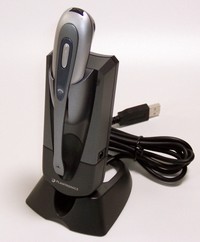
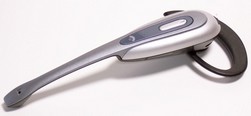
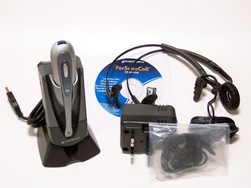
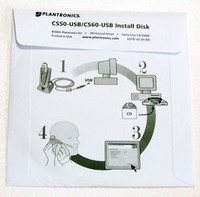
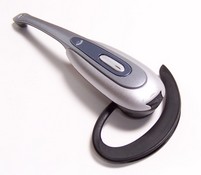
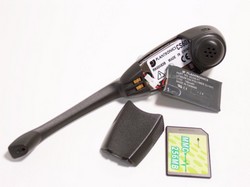
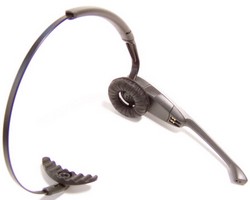



Why not just use a bluetooth headset with the PC or Laptop? This doesn’t seem to offer much more. Or am I missing something?
My experience is that Bluetooth is not…well…stable enough really for this kind of task. I’ve installed Bluetooth USB mic/headphone products and they tend to be a bit flaky in the driver department. For instance it took me three days to install a Jabra BT headset via a BT dongle, because something was clashing on the laptop I was using. Especially if you have more than one BT device on the same machine! YMMV. :-)
Regarding Bluetooth vs. DECT. The audio quality in the CS60 is MUCH MUCH MUCH better than any BT headset connected to a PC.
-Peter
Ah thanks Peter, forgot about that. Yes and also just remembered the range thing. I don’t think the BT stuff will roam much beyond a few meters if I remember correctly.